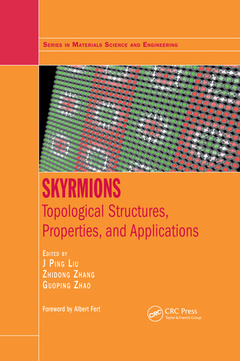Skyrmions Topological Structures, Properties, and Applications Series in Materials Science and Engineering Series
Coordonnateurs : Liu J. Ping, Zhang Zhidong, Zhao Guoping

"The book reviews all the aspects of recent developments in research on skyrmions, from the presentation of the observation and characterization techniques to the description of physical properties and expected applications. It will be of great use for all scientists working in this field." ? Albert Fert, 2007 Nobel Laureate in Physics (from the Foreword)
A skyrmion is a tiny region of reversed magnetization ? quasiparticles since they are not present except in a magnetic state, and also give rise to physics that cannot be described by Maxwell?s equations. These particles are fascinating subjects for theoretical and experimental studies. Moreover, as a new type of magnetic domain structure with special topological structures, skyrmions feature outstanding magnetic and transport properties and may well have applications in data storage and other advanced spintronic devices, as readers will see in this book. Chapters address the relationships between physical properties of condensed matter, such as the AB effect, Berry phase effect, quantum Hall effect, and topological insulators. Overall, it provides a timely introduction to the fundamental aspects and possible applications of magnetic skyrmions to an interdisciplinary audience from condensed matter physics, chemistry, and materials science.
Topological structure and properties. Breathing modes of confined skyrmions . Topology of magnetic domains. Dzyaloshinskii- Moriya interaction (DMI). From magnetic vortex to magnetic skyrmion. Skyrmion state in liquid crystal and cubic helimagnet films. Skyrmion spin texture using resonant soft x-ray scattering. Chiral Magnetic Domain Wall Structure in Epitaxial Multilayers. Experimental observations and materials. Formation and stability of skyrmions in low dimensional helimagnets. Creation and Dynamics of Individual Skyrmions in Helimagnets. Manipulation of magnetic skyrmions with spin-polarized STM. Chiral skyrmions in thin magnetic films for magnetic storage technologies. Simulations of skyrmion manipulation in confined geometries. Dynamics of Skyrmionic Spin Structures. Novel topological resonant excitations of coupled skyrmions in Co/Ru/Co nanodisks. Multiple-q States and the Skyrmion Lattice of the Triangular-Lattice. Heisenberg Antiferromagnet under Magnetic Field. Current-Induced Dynamics of Magnetic Skyrmion in Chiral Magnets. Dynamical magnetic skyrmions. Giant Skyrmions Stabilized by Dipole-Dipole Interactions in Thin Ferromagnetic Films. Zero-field stability, hysteretic behavior, and reversal mechanism of skyrmionic textures in nanostructures. Ground state, collective mode, phase soliton and vortex in multiband superconductors. Emerging applications. Current-induced magnetic skyrmions oscillator. Race-track application. Electrical Creation and Manipulation of Magnetic Skyrmion Bubbles. Guiding skyrmion motion on a track. Magnetic Vortex Nanostructures for Biomedical Applications. Rotating skyrmion lattices by spin torques and field or temperature gradients. Artificial Skyrmions
J. Ping Liu received his Ph.D. in Applied Physics at the Van Der Waals – Zeeman Institute, the University of Amsterdam, the Netherlands. He is currently a Distinguished Professor in the Department of Physics at the University of Texas at Arlington, USA and an Adjunct Professor at the Ningbo Institute of Materials Technology and Engineering, China. He is a Fellow of American Physical Society. His current research work is focused on nanostrucutred magnetic materials. He has organized and led several joint research programs in nanocomposite magnets supported by federal agencies including DOD/DARPA and DOD/MURI. He has authored or coauthored more than 220 peer-reviewed publications, including review articles, book chapters and a book. He has supervised more than fifty postdoctoral researchers and graduate students. He has organized and chaired numerous symposia and conference sessions including a symposium on Skrmions in July 2014 at Ningbo, China. Dr. Liu is the lead editor of Springer book “Nanoscale Magnetic Materials and Applications” (2009, among the top 20% most downloaded Springer text books).
Zhi-dong Zhang received his B.S. degree in the department of Physics, Nanjing University and his Ph.D degree in the Institute of Metal Research (IMR), Chinese Academy of Sciences. He is a full Professor of IMR and the head of Magnetism and Magnetic Materials Division since 1995. Dr. Zhang has been engaged in research on the fields of magnetism and magnetic materials and also condensed matter physics, including in the light rare-earth giant magnetostrictive materials, the magnetic nanocapsules, the nanocomposite magnetic thin films, the magnetocaloric materials and the theoretical work on Bose-Einstein Condensates and superfluids. Recently, he focused his interest in topological structures in magnetic materials, such as vortex and skyrmion, and their dynamical behaviors and resonant excitations. He has published more than six hundred papers in international journa
Date de parution : 03-2020
15.6x23.4 cm
Date de parution : 11-2016
15.6x23.4 cm
Disponible chez l'éditeur (délai d'approvisionnement : 15 jours).
Prix indicatif 220,72 €
Ajouter au panierThèmes de Skyrmions :
Mots-clés :
Ch Ap; Magnetic Skyrmions; skyrmion; Spin Texture; Dm Interaction; spintronics; Skyrmion Lattices; skyrmionic structures; Domain Walls; Lorentz Transmission Electron Microscopy; Spin Current; Spin Transfer Torque; Chiral Magnets; Vortex Core; Bloch Wall; Topological Charge; In-plane Current; Winding Number; FL; Magnetic Phase Diagram; Magnetic Vortex; Spin Helix; SW; Spin Structure; Spin Polarized Scanning Tunneling Microscopy; Hall Resistivity; Order Parameter Space; Resonant X-ray Scattering



